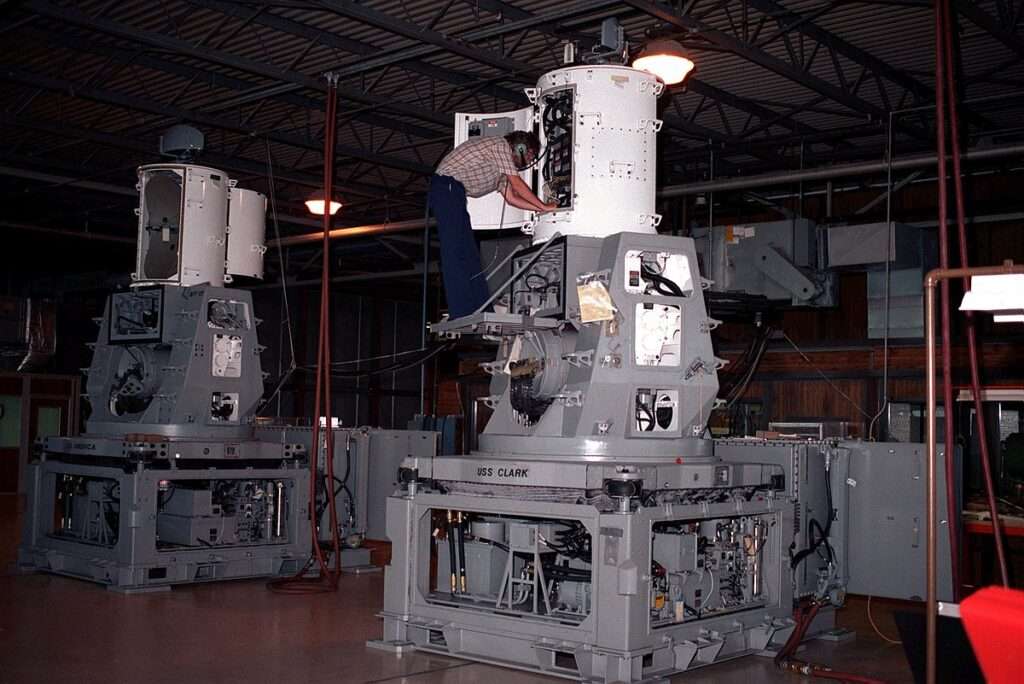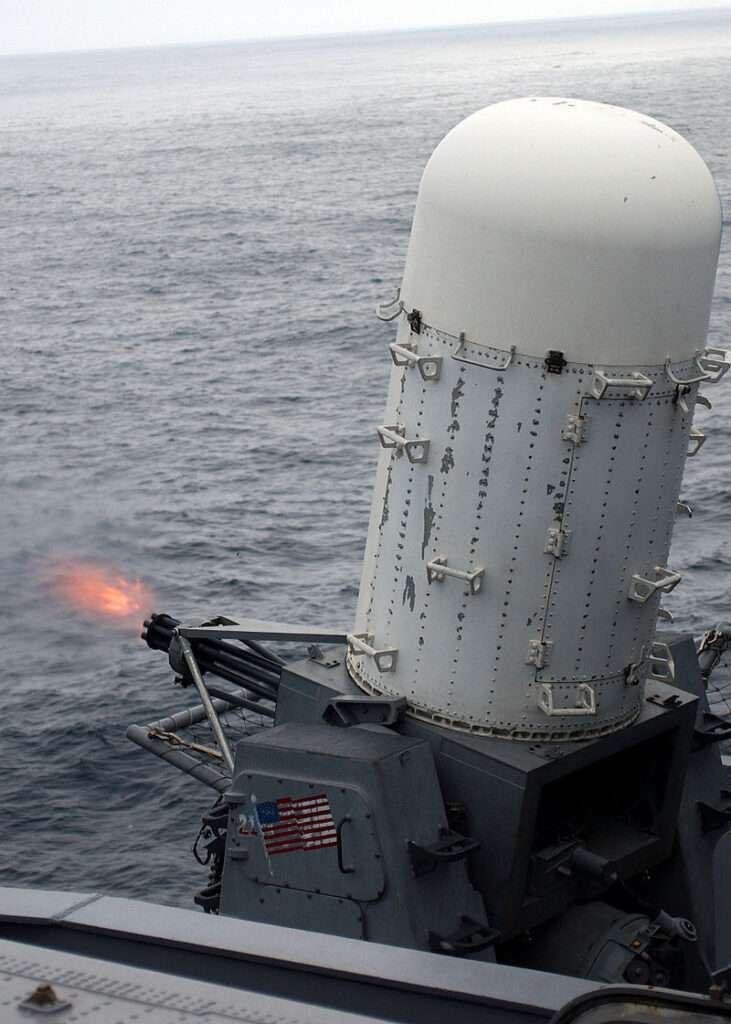Designed to counter threats from anti-ship missiles, aircraft, and other fast-moving targets, the Phalanx is a testament to the prowess of modern military technology.
In an era of advanced weaponry and evolving warfare tactics, naval forces require reliable and effective defense systems to protect against imminent threats.
One such system that has proven its worth is the Phalanx, a remarkable close-in weapon system (CIWS) used extensively by navies around the world.
Origins Of The Phalanx
The Phalanx has its roots in the 1960s when the United States Navy recognized the need for an effective close-in defense system for its ships.
The increasing threat of anti-ship missiles and the vulnerability of naval vessels necessitated the development of a rapid-fire, autonomous weapon system capable of engaging and neutralizing such threats.
 A technician checks the RADAR transmitter and Microwave assemblies in a Mk-16 Phalanx CIWS.
A technician checks the RADAR transmitter and Microwave assemblies in a Mk-16 Phalanx CIWS.
In response to this requirement, the U.S. Navy initiated a program in collaboration with the General Dynamics Corporation, which later became part of Raytheon, a renowned defense contractor.
The primary objective was to develop a close-in weapon system that could detect and engage incoming threats with exceptional speed and precision.
The development of the Phalanx was driven by advancements in radar and computer technology.
The system was designed to autonomously detect and track incoming threats, and then engage them with a high rate of fire, ensuring a swift and effective defense response.
Design Of The Phalanx
At the core of the Phalanx is the M61 Vulcan Gatling gun, a six-barrel, 20mm rotary cannon.
The gun is mounted on a stabilized platform, which ensures accurate and controlled firing even in turbulent sea conditions.
The Gatling gun is capable of firing up to 4,500 rounds per minute, delivering a formidable volume of firepower.
 A Phalanx CIWS while firing.
A Phalanx CIWS while firing.
To detect incoming threats, the Phalanx utilizes a combination of radar and electro-optical sensors.
The radar system continuously scans the surrounding airspace, searching for potential threats such as anti-ship missiles and aircraft.
The electro-optical sensors provide additional tracking capabilities and can operate in low visibility conditions, ensuring continuous surveillance and engagement capability.
The Phalanx radar system employs a pulse-Doppler radar, which allows it to differentiate between targets and clutter, effectively filtering out false positives.
This feature is crucial in maintaining the system’s high operational accuracy and preventing engagement of non-threatening objects.
Once a threat is detected, the Phalanx’ computing system, known as the fire control system, takes over.
The fire control system processes the radar and sensor data, determining the trajectory and speed of the target, as well as predicting its future position.
These calculations enable the system to accurately track and engage the threat.
 Servicemen unload dummy rounds and load live rounds into a Phalanx CIWS aboard the USS Harry S. Truman.
Servicemen unload dummy rounds and load live rounds into a Phalanx CIWS aboard the USS Harry S. Truman.
The fire control system employs advanced tracking algorithms to maintain a lock on the target and predict its movements.
This predictive tracking capability is essential for countering fast-moving threats such as missiles, which require rapid engagement to ensure the highest probability of interception.
When the Phalanx is engaged, the fire control system commands the Gatling gun to engage the target.
The gun rotates at high speed, and each barrel fires in rapid succession, delivering a continuous stream of projectiles towards the threat.
The high rate of fire, combined with the precision of the tracking algorithms, increases the probability of hitting and neutralizing the target.
To enhance its effectiveness, the Phalanx utilizes a concept called “controlled fire.” The system initially fires a burst of rounds to create a “beaten zone” in the path of the target.
By saturating the target area with projectiles, the system increases the probability of intercepting the threat, compensating for any errors in tracking or target prediction.
The Phalanx has a modular design, allowing for ease of maintenance and upgrades.
This modularity enables the integration of improved sensors, computing systems, and other technological advancements as they become available.
It ensures that the Phalanx can adapt to emerging threats and maintain its effectiveness over time.
 The Phalanx CIWS is sometimes nicknamed ‘R2-D2’ after the fictional Star Wars character.
The Phalanx CIWS is sometimes nicknamed ‘R2-D2’ after the fictional Star Wars character.
The Phalanx is typically installed on a pedestal or mount, strategically positioned on naval vessels to provide maximum coverage.
It can be integrated into a variety of platforms, including aircraft carriers, cruisers, destroyers, and amphibious assault ships.
Its small footprint and lightweight construction make it compatible with a range of ship sizes and configurations.
In addition to its primary role of engaging anti-ship missiles, the Phalanx can also be employed for close-in defense against aircraft and small surface targets.
Its versatility and adaptability make it a valuable asset in a variety of naval combat scenarios, ensuring the safety and protection of ships and their crew members.
Advancements and Variants
Since its introduction, the Phalanx has undergone several advancements and spawned various variants to meet the evolving demands of naval warfare.
These advancements have focused on improving target acquisition, enhancing tracking capabilities, and increasing the system’s overall effectiveness.
One significant advancement in the Phalanx’ evolution is the transition from the initial Block 0 variant to the Block 1B variant.
The Block 1B incorporates numerous improvements, including upgraded radar systems, enhanced electro-optical sensors, and improved computing capabilities.
These enhancements significantly enhance the system’s ability to detect and engage incoming threats.
 The Phalanx CIWS has been employed by navies all over the world.
The Phalanx CIWS has been employed by navies all over the world.
The Block 1B variant also features improvements in its tracking algorithms, enabling more precise and accurate target engagement.
The system can now track multiple threats simultaneously and engage them in rapid succession, further increasing its defensive capabilities.
To keep pace with emerging threats, the Phalanx has also seen advancements in ammunition types.
The introduction of new types of ammunition, such as armor-piercing discarding-sabot rounds, has expanded the system’s ability to engage a wider range of targets.
This advancement enhances the Phalanx’ effectiveness against hardened or heavily armored threats.
Moreover, the Phalanx has been integrated into various naval platforms, including surface combatants, aircraft carriers, and amphibious assault ships.
This integration has been made possible through the development of different variants and configurations of the Phalanx to suit the specific requirements of each platform.
For example, the Land-based Phalanx Weapon System (LPWS) is a ground-based variant of the Phalanx.
It is deployed to protect military bases, airfields, and critical infrastructure from aerial threats.
The LPWS retains the core components and functionality of the Phalanx but is adapted for land-based operations.
 The first ship fully fitted out was the aircraft carrier USS Coral Sea in 1980.
The first ship fully fitted out was the aircraft carrier USS Coral Sea in 1980.
Another variant of the Phalanx is the SeaRAM (Rolling Airframe Missile Guided Missile Weapon System). This system combines the Phalanx’ close-in defense capabilities with the Rolling Airframe Missile (RAM) launcher.
The SeaRAM integrates the Phalanx Gun’s radar and fire control system with RAM missiles, providing a multi-layered defense against various threats, including aircraft and anti-ship missiles.
The continuous advancements and development of variants demonstrate the adaptability and flexibility of the Phalanx to meet the changing threat landscape. These advancements ensure that the system remains at the forefront of naval defense technology, providing reliable and effective protection for naval vessels.
Looking ahead, future advancements may include the integration of advanced sensor technologies, such as active electronically scanned array (AESA) radars, for improved target detection and tracking.
Additionally, advancements in artificial intelligence and machine learning may enhance the system’s ability to detect and respond to emerging threats autonomously.
What Is the Best CIWS in the World?
If you want power, range, and agility, there is no better CIWS in the world than the Russian Kashtan. This CIWS is the best both in short and long range.
With 30 mm canons, eight turrets, and up to 32 surface to air 9m311 missiles, the Russian Kashtan outpaces all the other CIWS. With this CIWS, nothing is getting past its defensive system.
Conclusion
The Phalanx CIWS’ significance in modern naval warfare cannot be overstated. Its ability to autonomously detect, track, and engage fast-moving threats has made it a critical defense system for naval vessels.
The system’s success has led to the development of other advanced close-in defense systems and has opened doors for further advancements in technology.
As naval warfare continues to evolve, the Phalanx Gun is expected to remain at the forefront of naval defense, ensuring the safety and protection of naval forces worldwide.





